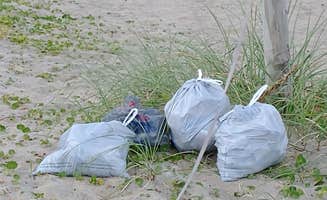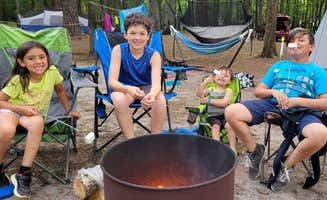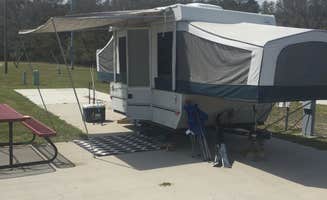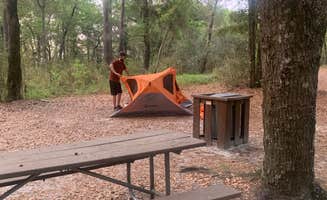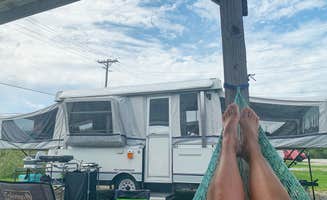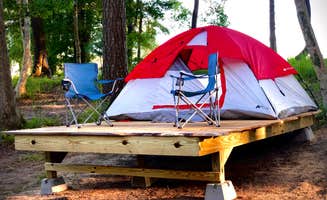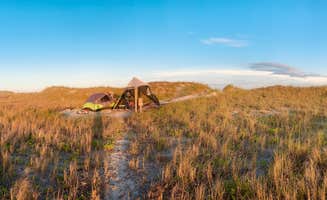Tent camping near Castle Hayne, North Carolina varies dramatically by season, with summer temperatures reaching 90°F while winter nights often drop to near freezing. The region's high humidity creates dense morning fog over waterways and swamps from October through March. During warmer months, insect repellent becomes essential equipment for campers throughout the coastal lowlands.
What to do
Kayaking Black River: Only 45 minutes from Castle Hayne, Black River Camping Ventures provides direct access to tea-colored waters with excellent fishing and wildlife viewing. "The river itself is and should be the center of your attention while you enjoy your stay. The tea-colored water provides excellent fishing, exploration by kayak or paddleboard, or it can be your next favorite swimming hole," notes camper Taylor B.
Beach camping off-season: Freeman Park offers a completely different beach camping experience during cooler months. "I camped here in March and had a great time. Daytime beachgoers were mainly fishing, walking their dogs, shelling, etc. There were half a dozen other campers, everyone was friendly and quiet," mentions Greg T. Most experienced campers recommend February-March or September-November for optimal conditions.
Military beach recreation: For those with military ID, Onslow Beach Campsites offers unique opportunities near Castle Hayne. "We have found many shark teeth on the beach and made great memories wake boarding and relaxing," says Paul R. The campground sits directly on the beach with access to both ocean and intercoastal waterway.
What campers like
Remote island camping: Hammocks Beach State Park Bear Island provides isolated beach camping with sites placed behind dunes. "The sites are well spaced and you won't feel on top of one another. It is also possible to canoe/kayak out to Bear Island from the main land if you have the time, experience and the conditions are right," according to Sarah C.
Wildlife watching: Lake Waccamaw State Park offers excellent nature viewing from tent sites. "The sites are all a far distance from one another so there's no chance of bothering one another at night. We had two neighbors during our stay but never heard or saw them, except when coming and going from the site to the parking area," reports Kristin T.
Early morning shelling: Bear Island at Hammocks Beach State Park provides exceptional shelling opportunities. "Get up EARLY for shelling, as professional shelters get there early to find good specimens," advises Kent F. The remote nature of the island means shell hunters often find intact specimens undisturbed by heavy foot traffic.
What you should know
Sand camping techniques: When tent camping at Fort Fisher Air Force Recreation Area, traditional tent stakes won't work. "Remember, when camping on sand, you don't need stakes. Instead you bring 4 plastic bags, fill them with sand, tie the tent corners to the bags and bury them in the sand. This will prevent your tent from flying away," advises Katy S.
Tide awareness: Beach campers must understand and monitor tide schedules. "CRITICAL to be educated about beach weather and TIDES!!!! Super high tides were present during my visit. A high Queen tide came near the camp spots at night while a super high king tide COMPLETELY COVERED the camp sites in the morning," warns a camper at Freeman Park.
Pack-out requirements: Many coastal campsites require campers to remove all trash. "There are NO trash cans or trash collecting points (even in the bathrooms), so you have to pack trash out," explains Kent F. about Bear Island. This practice helps maintain the natural environment but requires additional planning.
Tips for camping with families
Walking distances: At Lake Waccamaw State Park, tent sites require considerable walking from parking areas. "Sites 2-5 are a quarter mile plus from the parking area. I didn't read the key on the map, so that's my fault for not knowing. But just a heads up, especially sites 4 and 5 are very far from the bathroom. Don't forget anything in the car," advises Kristin T.
Ferry logistics: When planning family camping at Hammocks Beach State Park, consider transportation limitations. "Access will be a challenge for some. There is a state ferry that runs through the day (in season), but does not allow a cart to carry stuff. It's a long walk! We took a private ferry so we could bring what we wanted," reports Kent F.
Shade considerations: When camping with children at beach locations, prepare for limited natural protection from the sun. "There is very little shade at the primitive site areas, so hot, sunny days can be challenging. You can hang at the large shelters at the bathhouse, I suppose. Carrying a pop-up shelter would be grueling. A light sunshade would be good," suggests a Bear Island camper.
Tips for RVers
Military facilities: Military ID holders gain access to waterfront RV camping at Fort Fisher Air Force Recreation Area. "They do not allow wood burning fires, only propane campfires. Great staff. Beach access across the street. Less than a mile from the Aquarium and fort fisher civil war museum," reports camper E G.
Site arrangement challenges: Fort Fisher's campground layout can present difficulties for larger rigs. "The sites are back-in only and arranged on either side of a road that ends in a cul-de-sac that is too small to turn around in. The sites themselves are extremely long, but for some reason the hook-ups are all near the front of the site, so you can't take advantage of the length," notes Erin S.
Check-in logistics: Advance planning helps with navigating recreation area entrances. "Recommend parking at your site, then going to check in. Not much space to turn around at the office," advises E G. about Fort Fisher. Most military recreation areas require ID verification before proceeding to campsites.


